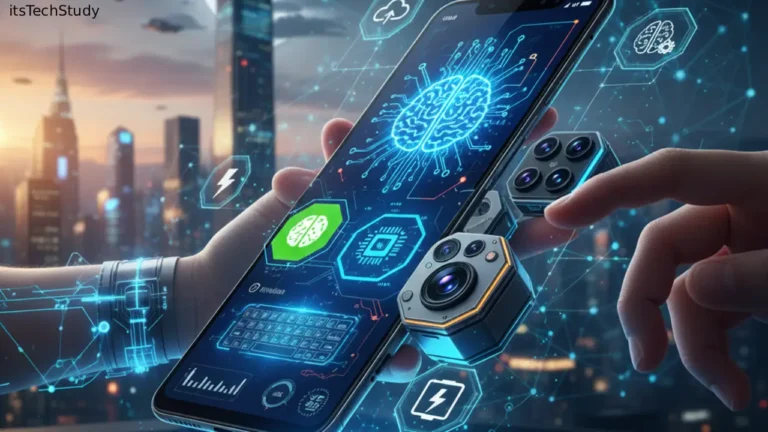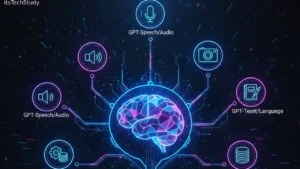Introduction: The Evolution That Never Stops
A decade ago, owning a smartphone that could stream HD videos, play console-quality games, and handle professional-level photography seemed futuristic. Fast-forward to 2025, and these capabilities are not just common – they’re expected. But what’s driving this unprecedented leap in mobile innovation?
The answer lies in the synergy of three key technologies: 5G networks, artificial intelligence (AI), and next-generation chipsets. Together, they’re rewriting the rules of mobile computing, transforming how we connect, communicate, and create in a world increasingly powered by the cloud, web, and edge computing.
This powerful trio – 5G, AI, and chipsets – forms the backbone of modern mobile experiences. From instant app responses to real-time augmented reality (AR), and from seamless cloud gaming to advanced image recognition, every innovation traces back to how these technologies interact and evolve.
But how exactly are they redefining mobile technology today? Let’s dive deep into this transformative ecosystem.
1. The Power of 5G: Building the Foundation for Future Mobility
5G isn’t just another “upgrade” from 4G – it’s a complete reimagination of connectivity.
1.1. Speed, Latency, and Capacity Revolution
5G networks are designed to deliver:
- Up to 10 Gbps speeds – nearly 100x faster than 4G LTE.
- Ultra-low latency – as low as 1 millisecond, making real-time processing possible.
- Massive device connectivity – supporting up to 1 million devices per square kilometer.
This means your smartphone isn’t just connecting to the internet – it’s becoming part of an intelligent, always-connected web of devices.
Whether you’re streaming 8K videos, playing NVIDIA GeForce NOW cloud games, or participating in real-time virtual meetings, 5G ensures smooth performance without lag.
1.2. The Role of Cloud and Edge Computing
With 5G, cloud integration is becoming seamless. Instead of processing everything locally, smartphones can now offload heavy workloads – such as gaming graphics, AI analytics, or data rendering — to the cloud or edge servers.
This shift allows manufacturers like Intel, Qualcomm, and NVIDIA to design chipsets that focus on energy efficiency and intelligent task distribution.
1.3. 5G Use Cases in Mobile Technology
| Application | Impact of 5G | Example |
|---|---|---|
| Cloud Gaming | Instant play with no downloads | NVIDIA GeForce NOW, Xbox Cloud Gaming |
| Video Streaming | 4K/8K streaming with zero buffering | YouTube, Netflix, Twitch |
| AR/VR Experiences | Real-time immersive content | Pokémon GO, Meta Quest |
| IoT Integration | Smart home & wearables communication | Google Nest, Samsung SmartThings |
| Remote Work | High-quality video conferencing | Zoom, Google Meet |
5G has made mobile devices the centerpiece of digital ecosystems, powering everything from smart cars to connected factories.
2. Artificial Intelligence: The “Brain” Behind Smart Devices
If 5G is the nervous system, AI is the brain of modern mobile technology. It’s what makes smartphones intelligent – learning user habits, predicting actions, and optimizing performance.
2.1. AI’s Role in Everyday Mobile Experiences
AI is integrated into nearly every mobile function today:
- Camera optimization: AI automatically adjusts lighting, color, and focus.
- Voice recognition: AI assistants like Google Assistant or Siri process natural speech.
- Battery management: AI predicts usage patterns to extend battery life.
- App recommendations: AI learns preferences for personalized app suggestions.
This evolution is made possible through dedicated AI accelerators inside chipsets, such as Neural Processing Units (NPUs) or Tensor Cores.
2.2. AI-Powered Hardware: A Quiet Revolution
Companies like Intel, NVIDIA, and Qualcomm are redefining mobile AI performance:
- Intel’s AI Boost: Embedded within new mobile chipsets, enabling faster machine learning inference on-device.
- NVIDIA’s Tensor Cores: Originally for GPUs, now adapted for mobile and embedded systems.
- Qualcomm Snapdragon AI Engine: Capable of 45+ trillion operations per second (TOPS).
These advancements enable on-device intelligence, reducing dependency on cloud-based AI, and preserving privacy while improving speed.
2.3. AI and Cloud Synergy
Although on-device AI is growing, AI still thrives in the cloud for deep learning and data-intensive tasks. 5G’s ultra-fast connectivity bridges the gap between local processing and cloud computing, creating a hybrid intelligence model – efficient, powerful, and scalable.
3. Chipsets: The Heart of Modern Mobile Devices
3.1. Why Chipsets Matter
Chipsets are the core engines of smartphones – responsible for processing data, rendering graphics, managing AI, and connecting to 5G networks. Every app, photo, and game you experience is processed through the silicon circuits of these tiny but mighty chips.
3.2. The Rise of Integrated System-on-Chip (SoC) Design
Modern chipsets are not just CPUs. They are System-on-Chip (SoC) solutions combining:
- CPU (for computing)
- GPU (for graphics)
- NPU (for AI)
- ISP (for image processing)
- Modem (for 5G connectivity)
This integration improves efficiency, speed, and power management, allowing smartphones to perform desktop-level tasks.
3.3. Leading Chipset Innovations
| Chipset Brand | Flagship Processor (2025) | Key Features |
|---|---|---|
| Qualcomm | Snapdragon 8 Gen 4 | 3nm process, integrated AI Engine, enhanced GPU |
| Apple | A18 Bionic | Neural Engine for AI, 3D rendering power, 5G modem |
| Intel | Core Ultra Mobile | Hybrid architecture, AI acceleration, energy efficiency |
| NVIDIA | Tegra Orion | AI + GPU fusion for AR/VR and gaming |
| MediaTek | Dimensity 9400 | Cloud-optimized performance, integrated 5G modem |
The competition among Intel, NVIDIA, and Qualcomm is driving new levels of performance and innovation – with AI at the core of every design.
4. The Synergy: 5G, AI, and Chipsets Working Together
These technologies are powerful individually — but when combined, they unlock exponential growth.
4.1. Real-Time Intelligence
5G delivers lightning-fast data transfer, while AI processes information instantly on the chipset. This enables:
- Instant translations via cloud-based AI.
- Real-time AR navigation with GPS precision.
- Smarter photography analyzing thousands of images per second.
4.2. Cloud Integration and Edge Computing
With 5G, devices can rely more on the cloud and edge servers for computing-heavy tasks. AI helps determine what stays on the device and what moves to the cloud.
This balance optimizes speed, energy use, and performance – a model companies like Intel and NVIDIA are heavily investing in.
4.3. Enhanced Security Through AI and Chipsets
AI-enabled chipsets now detect threats in real-time, ensuring better protection against malware and phishing attacks. 5G’s network slicing further isolates data streams, keeping personal and business information secure.
5. Benefits and Drawbacks: The Real Picture
Pros of 5G, AI, and Chipset Integration
- Ultra-fast connectivity and processing power
- Smart automation and personalized user experience
- Enhanced data security and predictive protection
- Better cloud and web integration for mobility
- Improved power management and battery optimization
Cons
- High development and device costs
- Increased power consumption for early 5G chips
- Network availability still uneven in rural regions
- Complexity in hardware-software optimization
6. The Role of Cloud and Web Integration in Next-Gen Mobile Tech
6.1. Cloud as the New Processing Hub
The cloud has become an extension of the smartphone’s brain. With 5G, it allows devices to:
- Store massive data without local storage limits
- Access powerful AI tools remotely
- Sync apps and files across platforms instantly
Example: NVIDIA’s cloud-based AI models help optimize camera image quality and enhance AR experiences directly from the web.
6.2. Web 3.0 and Decentralized Mobile Ecosystems
Emerging Web 3.0 technologies – powered by 5G and AI – are giving users more control over data, privacy, and identity. Mobile apps can now use blockchain-backed cloud storage for transparent and secure access.
7. Use Cases Transforming the Mobile Experience
7.1. Smart Photography and Videography
AI chipsets use real-time scene detection, HDR optimization, and edge processing for cinema-quality visuals – a field where NVIDIA and Apple lead innovation.
7.2. Gaming on the Go
5G’s high bandwidth + AI optimization = seamless mobile gaming.
Intel Arc graphics and NVIDIA GeForce NOW cloud gaming platforms are redefining the meaning of “mobile entertainment.”
7.3. Health and Fitness Tech
AI-powered sensors and 5G connectivity allow mobile devices to track real-time health data, sending updates securely to cloud-based platforms or healthcare providers.
7.4. AR/VR Applications
The combination of 5G’s low latency, AI’s object recognition, and powerful chipsets enables realistic augmented and virtual reality experiences right on smartphones.
8. The Future: Where Are We Headed?
The future of mobile technology will be defined by:
- AI-driven chip design (self-optimizing processors)
- 6G networks – 100x faster than 5G
- Fully cloud-native smartphones
- Cross-device computing where your phone seamlessly connects with laptops, wearables, and IoT devices
Companies like Intel, NVIDIA, and Qualcomm are already shaping this vision – where devices are not just smart, but autonomous digital companions.
Conclusion: The Smartest Era of Mobility Has Begun
The convergence of 5G, AI, and advanced chipsets marks the most transformative era in mobile history. Together, they’re not just enhancing devices – they’re reshaping human interaction with technology.
As cloud and web ecosystems evolve, our phones are becoming intelligent companions – capable of learning, predicting, and acting in real-time. With industry giants like Intel, NVIDIA, and Qualcomm at the forefront, the line between mobile and desktop computing is fading fast.
The future is hyper-connected, cloud-driven, and AI-powered – and your smartphone is right at the heart of it.
Frequently Asked Questions (FAQ)
Q1: How does 5G improve mobile performance compared to 4G?
Ans: 5G offers much faster speeds, significantly lower latency, and can connect more devices simultaneously. This enables seamless streaming, faster downloads, and smoother cloud-based operations.
Q2: How does AI make smartphones smarter?
Ans: AI enhances everything from photography and voice assistants to security and battery efficiency by learning user behavior and making intelligent, real-time adjustments.
Q3: What role do chipsets play in 5G and AI integration?
Ans: Chipsets act as the central processing unit, combining CPU, GPU, and AI engines to execute tasks efficiently. They enable real-time communication and processing required by 5G and AI.
Q4: Is the cloud essential for modern mobile devices?
Ans: Yes. The cloud extends storage, computing power, and AI capability beyond what the device can handle locally — allowing for better performance and data access anywhere.
Q5: Are Intel and NVIDIA involved in mobile chip development?
Ans: Absolutely. Intel focuses on hybrid AI-enabled mobile CPUs, while NVIDIA contributes its GPU and AI technologies for mobile gaming, AR/VR, and edge processing.
Q6: What challenges remain for 5G and AI integration?
Ans: Key challenges include power efficiency, affordability, and ensuring global 5G availability. Manufacturers continue to innovate with smaller, more energy-efficient chips.












No Comments Yet
Be the first to share your thoughts.
Leave a Comment